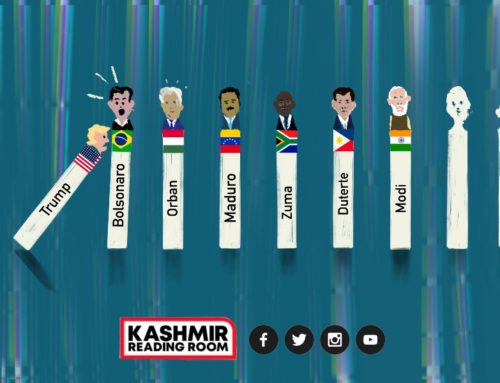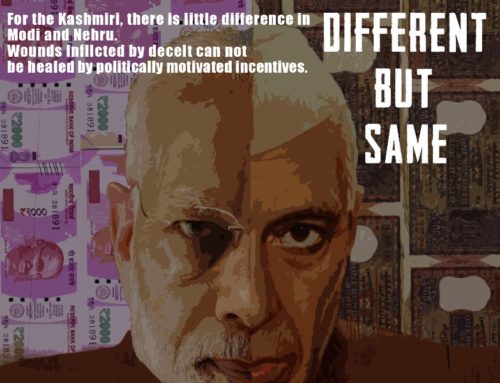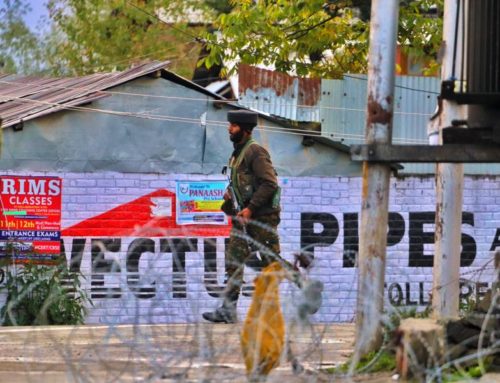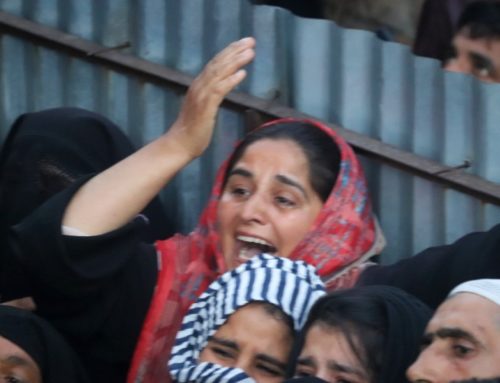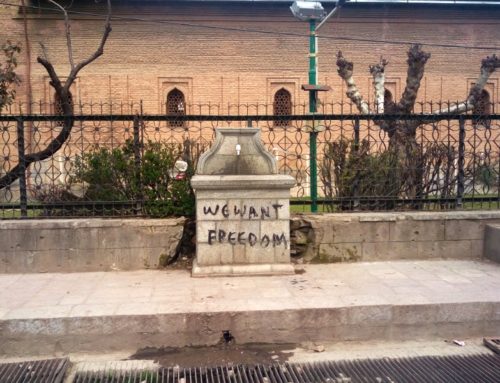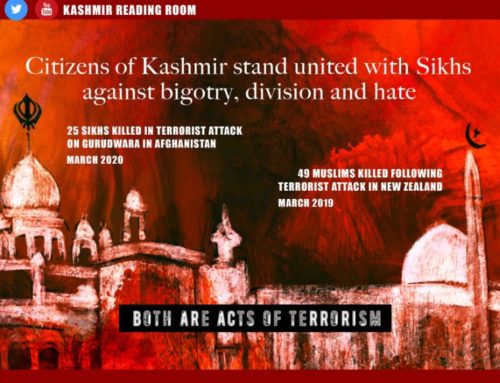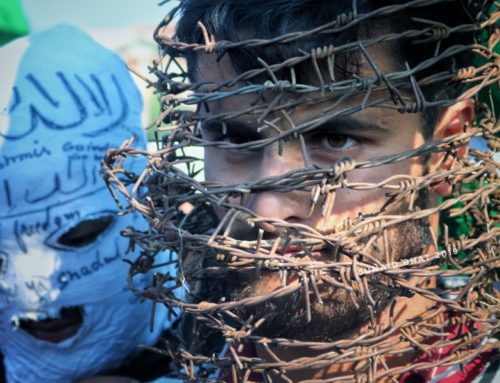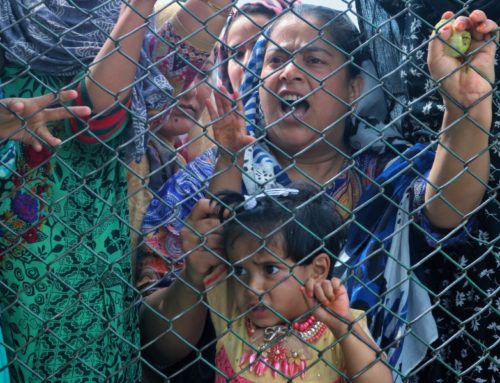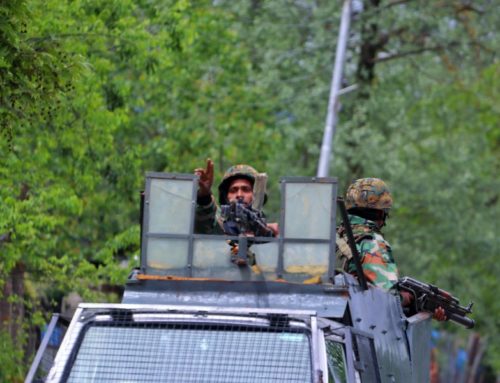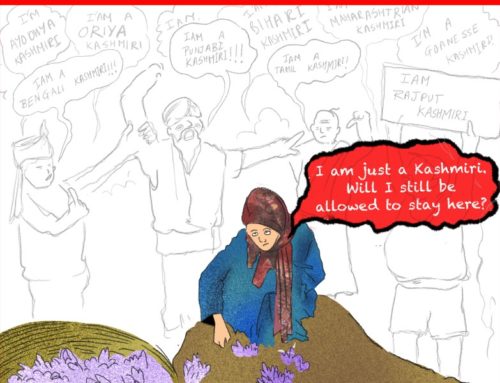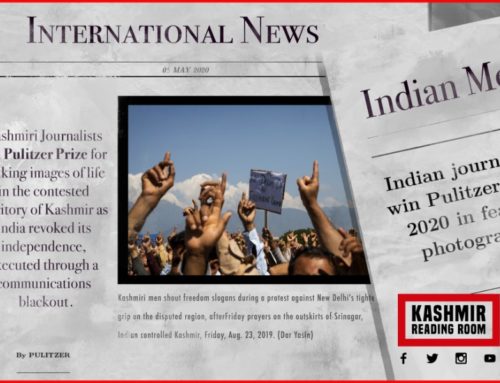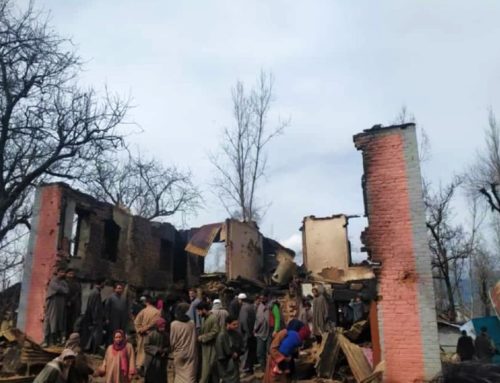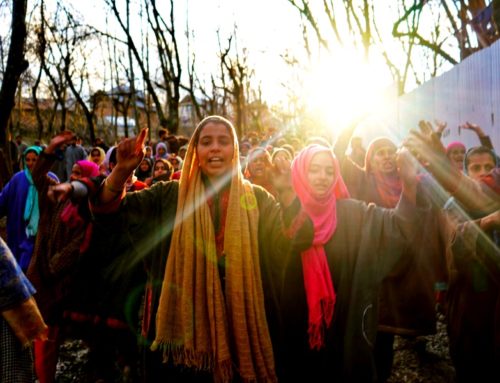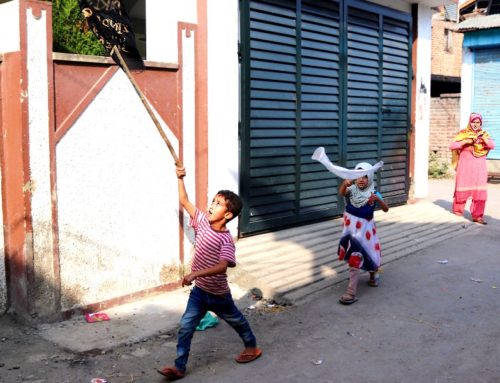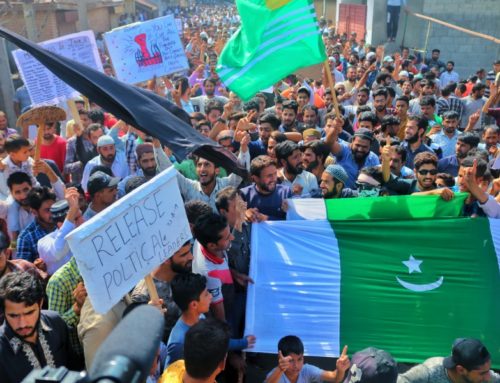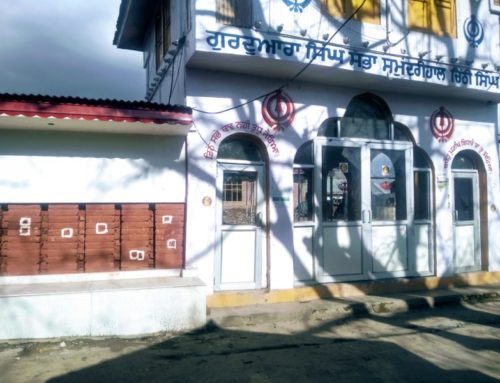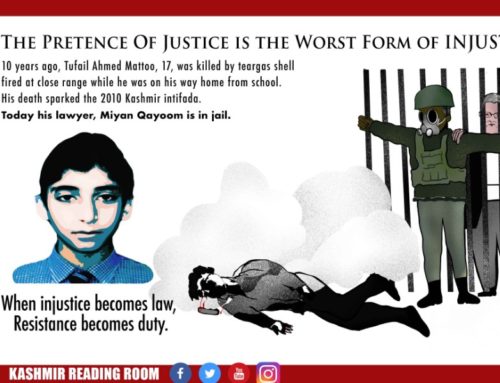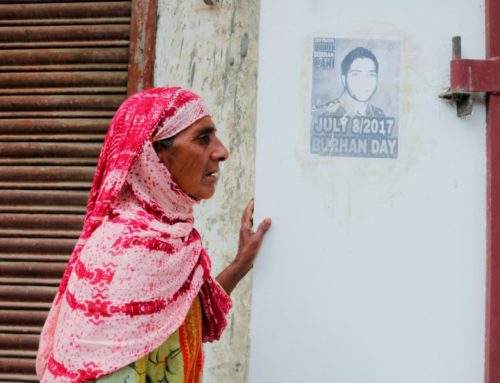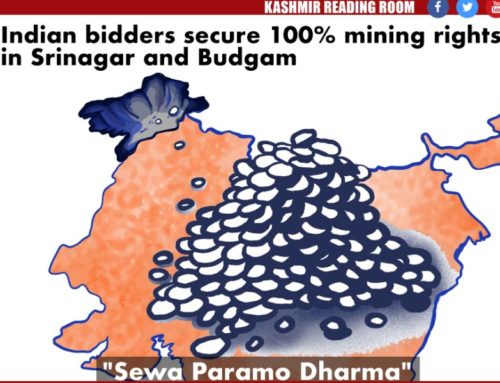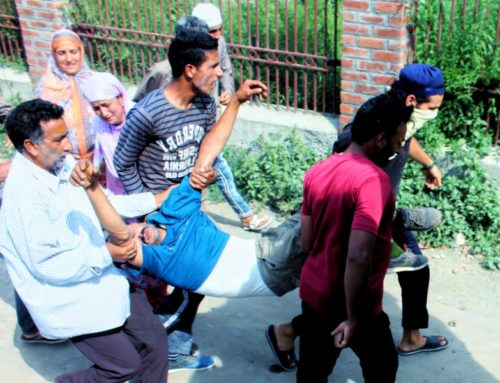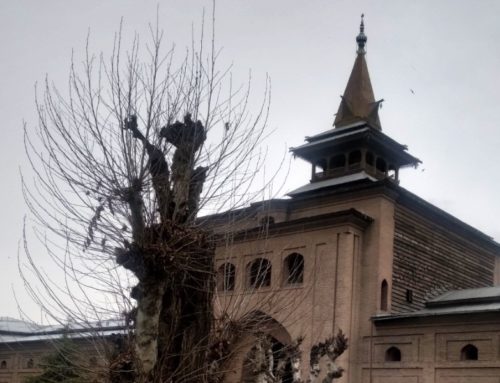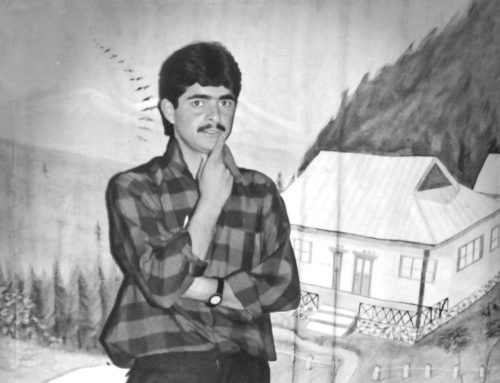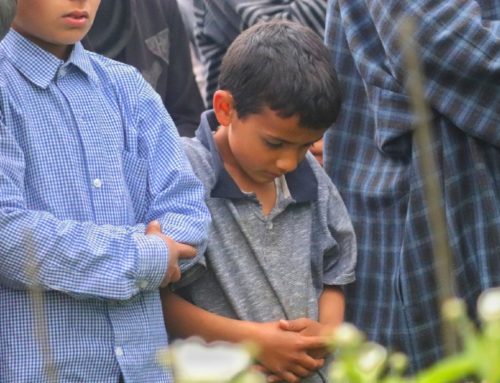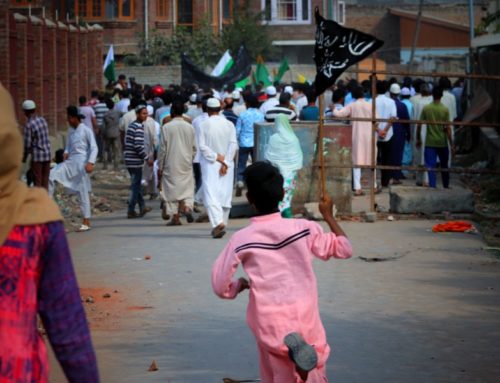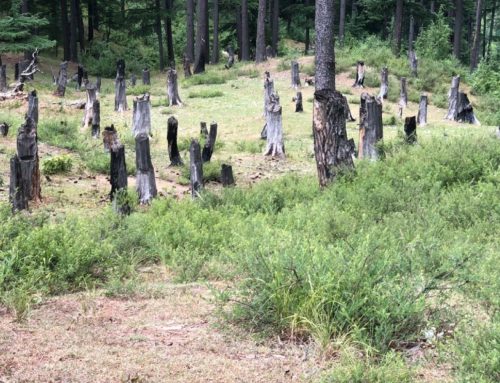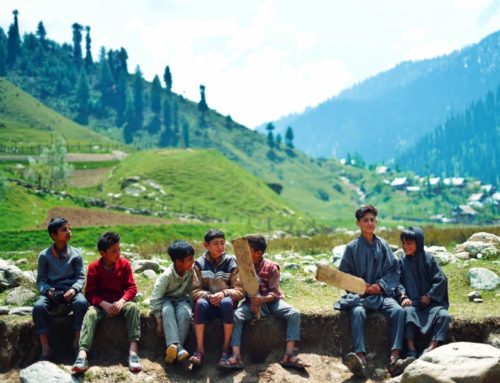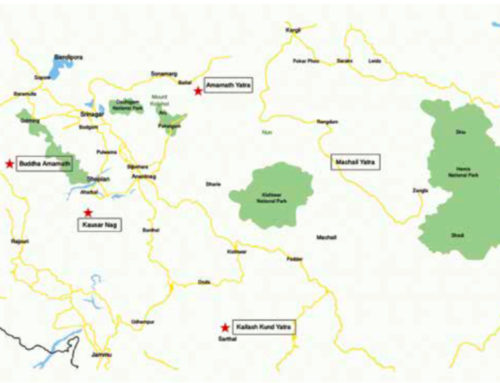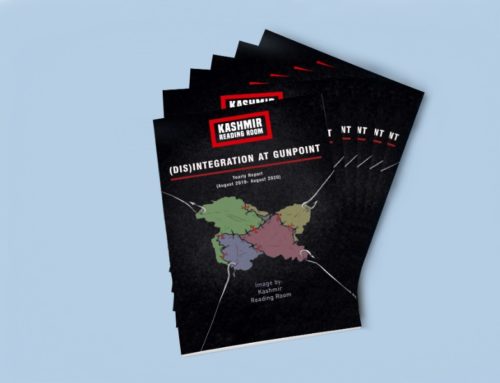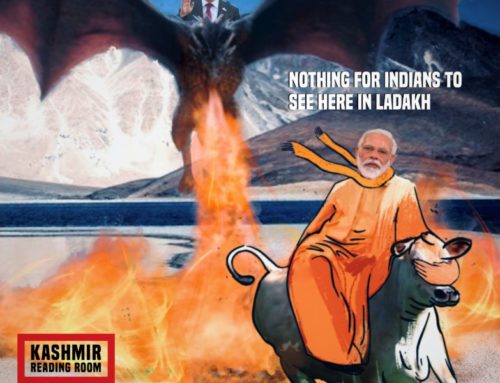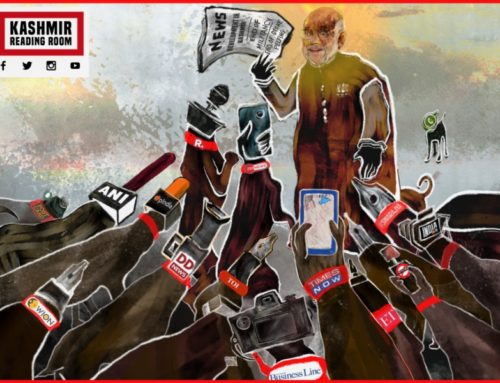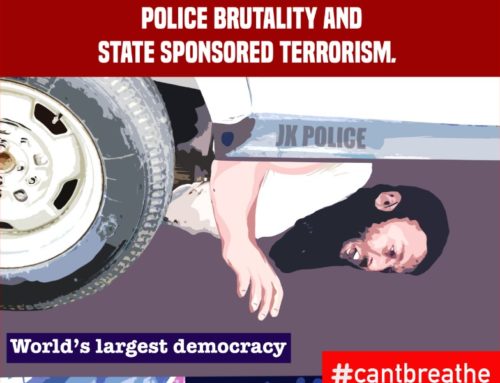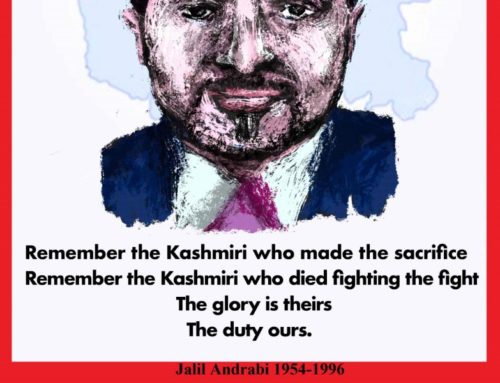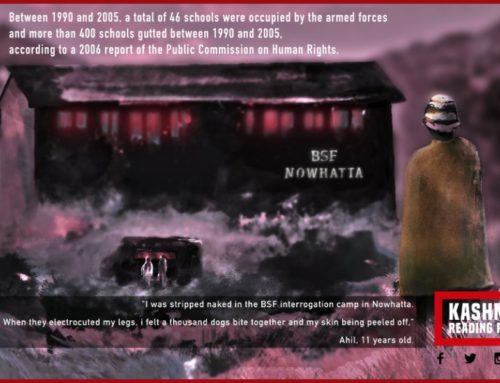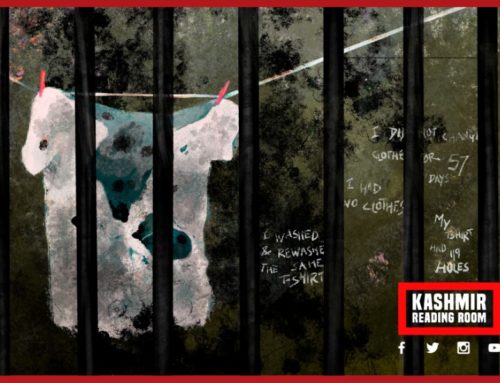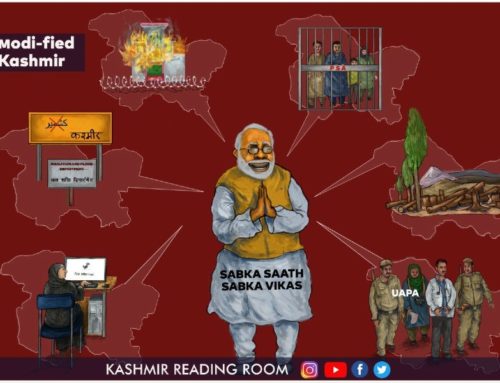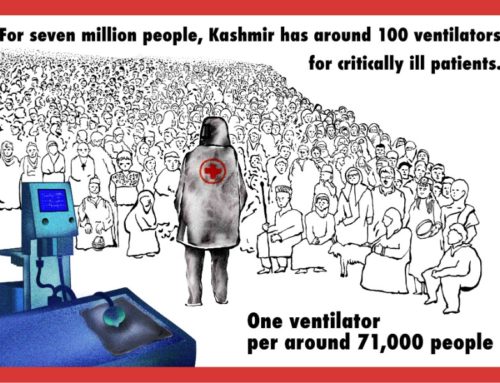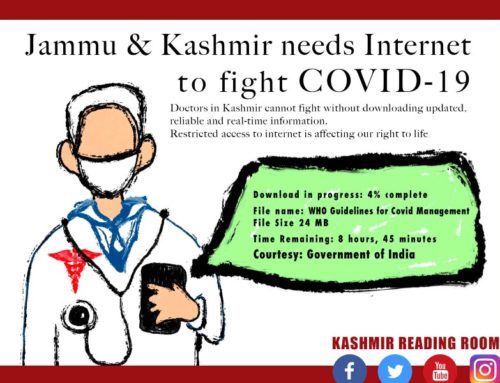Militarism in Kashmir Since August 5, 2019
Sarthak Tomar
During the early hours of August 5, 2019, the Jammu & Kashmir(J&K) Police started detaining political leaders and activists from their homes. Over the next two weeks, somewhere between 4000 to 6000 people were detained – many without any formal charges. On November 20, 2019, the Ministry of Home Affairs informed the Indian Parliament that 5,141 people were detained since August 5, 2019, while reiterating that the situation in J&K is ‘normal’. Amongst these detained, more than a hundred were minors, few as young as 9 years of age. Police officers told journalists that there were instances of detention without any formal police documentation for the same. Many of these detainees were moved to prisons in other states of India.
Military Planning Before August 5, 2019
Within hours after the announcement of the abrogation of Article 370 and 35A the city of Srinagar was under lock-down under a new strategy, reportedly planned by either an American or Israeli contractor. With complete restriction on movement even journalists with ‘curfew pass’ were regularly stopped, beaten and denied access at checkpoints. The Internet was completely shut down and telecommunications highly restricted. The intelligence agency National Technical Research Organisation (NTRO) set up a massive Internet and telecommunications surveillance network. In terms of direct military planning and strategy there seems to have been no major shift after August 5, 2019. Except in smaller pockets and reduced frequency there were almost no major protests that required a shift in crowd control tactics.
In November 2019, the Cabinet Secretariat notified that “the Ministry of Home Affairs would be responsible for all matters relating to the Union Territory of Jammu and Kashmir or Union Territory of Ladakh, including counter terrorism within Jammu and Kashmir, and coordination with the Ministry of Defence as regards manning and managing the Line of Control between India and Pakistan, but excluding those matters with which the Ministry of External Affairs was concerned.”
In 2018 the number of boots on ground in J&K was 4.7 lakh personnel including the 1.3 lakh strong State police force. These numbers exclude the non-combatant military personnel and divisions of the Indian armed forces not engaged in any counterinsurgency or crowd-control operations within the state. The number of engaged armed forces in Kashmir valley alone in 2018 was 2,10,000 – 28.5 personnel for 1000 civilians. In August 2019, over 1.75 lakh new troopers were deployed in the State, mostly in the Kashmir Valley. An official called the preparation “war like”. Most of the soldiers were from CRPF (40,000). Expecting confrontation and violence at least 100 doctors were also brought in for the soldiers.
On 2020-21, the budget allocation to the Ministry of Defence has been the highest among all ministries of the central government. In 2020-21 the total Ministry of Defence budget is INR 4,71,378 cr. India’s defence expenditure constitutes 15.5% of the central government’s budget and 2.1% of India’s estimated GDP for 2020-21.. Tellingly, the budget for Health is a paltry INR 69,234 cr, around five-six times less than the defence spending.
This budget was introduced on February 1, 2020, when almost every country in the world was preparing its healthcare system to adequately deal with the global spread of COVID-19.
House Raids by Indian Armed Forces in Kashmir
On May 8, 2020 a series of house raids by Indian armed forces were undertaken in Budgam district. The personnel involved, engaged in property damage, looting, beating and attacking civilians by rubbing salt in their eyes and as one woman recalled “they shoved the barrel of their guns in our mouths” to stop us from screaming. Many houses and shops were raided and heavily damaged. There are multiple reports of increase in the number of raids since August 5, happening almost every day or at least a few times every week especially in villages in south Kashmir and in Srinagar. In a report the modus operandi has been described as:
“‘They barge into the village screaming abuses and throwing stones at the houses breaking window panes. Almost all the houses in the villages and some neighborhoods in Srinagar, have broken windows owing to the stones thrown by the army. One of their favorite taunts is that they are going to choose girls from this village to get married to and that they are going to take over all the land in the village and nothing can be done to them. During these raids, which are usually past midnight, the Army jawans are usually drunk though not the police. The men are rounded up on the main road and their mobile phones are taken away from them and checked. Simultaneously the armed forces enter all houses in the name of conducting checks, women and girls are physically frisked by male army personnel, are sexually abused and molested. If they try to defend themselves, they are physically abused.’ We were told that the sexual abuse is rampant, as one youth said, ‘Maa kya hote hain, behan kya hote hain, unko kya maloom’. In a village we visited we were told, ‘Of late, people shut the doors and windows and stay indoors at night, in fear of raids. The armed forces now come and arbitrarily throw stones at windows to instigate the people to step out and if they do so, they force in and ransack the house. This harassment continues all night, leading to fear and mental breakdown amongst those in the neighborhood’. In several villages we were told that the jawans take away whatever they please and any protest is met with the choicest of abuses and beatings. In another village we were informed that even the SOG [Special Operations Group, a special Police force in J&K] robs gold and money during these raids. The jawans taunt people saying that ‘sala azaadi maangta hai, Modiji azaadi diya hai’.’ ”11
In many of the raids, boys under the age of 18 and young men are asked to come to the police station, army camp or Joint Interrogation Camp. Family members are detained for questioning in lieu in absence of the person. The families are unaware of the location of detention, person’s whereabouts and have no legal recourse.

House damaged in Arampora Sopore encounter
Excessive use of Force in 2019
The J&K SHRC in its report ‘Details of Pellet Victims of 2016 Unrest’ said that 3967 people were injured by the metal pellets firing shotgun used by armed forces. These were introduced in the valley in 2010, under the UPA in center. In 2017 and 2018, the number of injured people was 164. In 2019, at least three civilians lost their lives from pellet injuries and four from tear gas and pepper gas used for crowd control by the police and CRPF during protest or near the militant encounter sites. After August 5, the media significantly reduced reporting injuries from crowd control measures but at least 100 people received pellet injuries in the Zadibal area between September 1 and September 10, 2019. The use of pellet guns is considered against international legal standards and has been noted to violate proportionality principle, not in the least for the violation of right to life. Such force is not only used against protesters throwing stones at armed forces, peaceful protesters are beaten regularly.
In June 2019, the CRPF requested Long Range Acoustic Device (LRAD), a sound cannon as a new tool for crowd control. They also intended to use it in mainland India and there are reports of anti-riot vehicles being equipped with LRAD in Arunachal Pradesh.Acoustic weapons cause permanent damage and could be fatal for people with special conditions.
‘Hit lists’ ‘CASOs’ and Killing of Militants
In 2016, after the encounter of Burhan Wani, a new and massive protest wave erupted in the Kashmir Valley. The Indian military initiated Operation Calm Down in its response and 4000 new troopers were rushed into the four districts of South Kashmir–Pulwama, Shopian, Anantnag and Kulgam. In next few months the national security establishment created a hit-list as a part of Operation All-Out in mid-2017 with 136 Lashkar-e-Taiba, 95 Hizbul Mujahideen and 23 Jaish-e-Muhammad militants. Op. All Outs’ major components are the Cordon and Search Operations (CASOs). According to a 2019 Office of the United Nations High Commissioner for Human Rights report, the “[s]o-called ‘cordon and search operations’, a much-criticized military strategy employed by the Indian security forces in the early 1990s, was reintroduced in the Kashmir Valley in 2017. According to national and international human rights organizations, cordon and search operations enable a range of human rights violations, including physical intimidation and assault, invasion of privacy, arbitrary and unlawful detention, collective punishment and destruction of private property.”
In 2017, 206 militants were reported to have been killed in these operations. Since 2017, these operations have been focused in South Kashmir, but reports suggest that they will shift their focus and move north from July 2020. Between January 1 and June 19, 102 militants had been killed during CASOs, with higher rates during the COVID-19 lockdown – 72 between March 20 and June 19. There were 120 cases of property damage, 31 private houses completely burned down in 2017. While there is no available data of property damage during ongoing CASOs the number seems to be on the rise. January – June 2020, recorded 48 cases of property damage. In over 300 such cases in the last 3 years, none of the families have received any compensation.
In 2020, between January 1 and June 6, 135 Over Ground Workers (OGWs) were arrested by J&K security forces. Although, an OGW is usually defined as a person directly engaged in assisting militants by providing logistics, financial assistance, safe houses, etc. The categories and definitions are used pretty much freely to justify various instances of civilian killings.
On June 10, 2020 Ajay Pandita, a Congress affiliated sarpanch from Lukbawan was killed by two unidentified gunmen. Since August 5, 2019, the personal security for Congress leaders has been revoked making them more vulnerable to militants. According to one report, “[i]mmediately after the killing, the state Congress chief Ghulam Ahmad Mir had said that Mr. Ajay Pandita had informed the district authorities that he had felt vulnerable since a few months and had requested security cover from the district police. His requests, Mir added, were not entertained by the district authorities.”
In 2020, attacks on health care workers by security forces continued including on epidemiologist Dr. Muzaffar Ahmad, by CRPF, and on ambulance driver Tariq Ahmad and cardiologist Dr. Syed Maqbool, by the police.
India’s Military Strategy
One Indian military analyst in 2017 noted that, “[t]he reasons for this tactical shift (in last decade), from population-centric measures forming the foundation of the counter-insurgency (COIN) strategy to one where some degree of collateral impact is acceptable, is fundamentally linked to the belief that the enemy centric tactics used by the British, the French and the Algerian strategists are suitable only for colonial or interventionist armies fighting in foreign lands” and, that “it can be concluded that a large gamut of India’s COIN response is being conducted either without any doctrinal assistance or has been shaped by the legacy of the British, ironically by the ways and methods in which the former colonial masters dealt with the natives.”
India does not have a single COIN doctrine. The 2006 “Doctrine For Sub Conventional Operations” has a more broad scope and focuses only on the Army while the CASO like operations involve the police and at times other special forces. But the overall aim of such doctrine or “grand strategies” are general and remain constant: To “provide an insight into various lines of operations undertaken by the (armed forces) to create a secure and conducive environment for the fulfillment of national policy strategy.”
Nitin Gokhale, while praising Modi, called the post 2016 military actions in Kashmir as part of “peace first, political outreach later” approach. ‘Peace’ here is a technical term which means ‘a secure and conducive environment for’ whatever New Delhi desires and as in this case, does not necessarily mean termination of the cycle of violence. What it desires and what the ‘national policy strategy’ seeks must be clear to the reader from other chapters in this publication.
Military establishment knows there are no military solutions to insurgencies. According to one analyst, by the mid-1980s Indian “army officers appeared convinced that only political solutions could end insurgencies.” What the armed forces hope to achieve is to keep militant groups on the defensive, reduce the damage they can cause and prevent them from gaining enough momentum to grow from guerrilla groups to some form of formal military formation. One wonders if this requires 4-7,00,000 troopers.
The goal of such heavy militarization seems to be the maintenance of control over the street and life in the valley. One would recall that the 2019 – ‘war like’ mobilization was not in response to any increased risk of militant activities but due to the fear of 2016 like protests. The rationale for maintaining such control in the most brutal fashion is sometimes called the Doval doctrine, according to which the hostile natives should realize that “[i]n the game of power the ultimate justice lies with the one who is strong.”
Conclusion
In the last one year, the number of boots on ground has significantly increased, the surveillance systems have penetrated more deeply, civilian deaths by militants and Indian forces have continued to rise. Systemic harassment, sexual violence, property damage, mass and arbitrary detention and torture continue to be the norm. Civilians are maimed for life and are killed regularly and systematically in the name of crowd control. The draconian laws like Armed Forces Special Powers Act and Public Safety Act that enable these atrocities remain intact. There have been no independent and impartial inquiries by the Indian state into the countless human rights violation cases, the 8000 missing people or the unmarked graves in the valley.
The first wave of militants in Kashmir emerged due to Kashmirs’ complete political disconnect from New Delhi and today, by not addressing the social and political grievances, enforcing a settler colonial apparatus, humiliating and degrading day to day life of the people, the Indian state and its military planners are ensuring further rise in militancy, an ever increasing and never ending ‘hit-list’ and an ever increasing military budget, which is already eating away most of Indian social spending.
It appears that in the foreseeable future, the approach and main strategy of the Indian national security leadership will be the use of brute force, oppression and suppression under the pretext of controlling militancy.
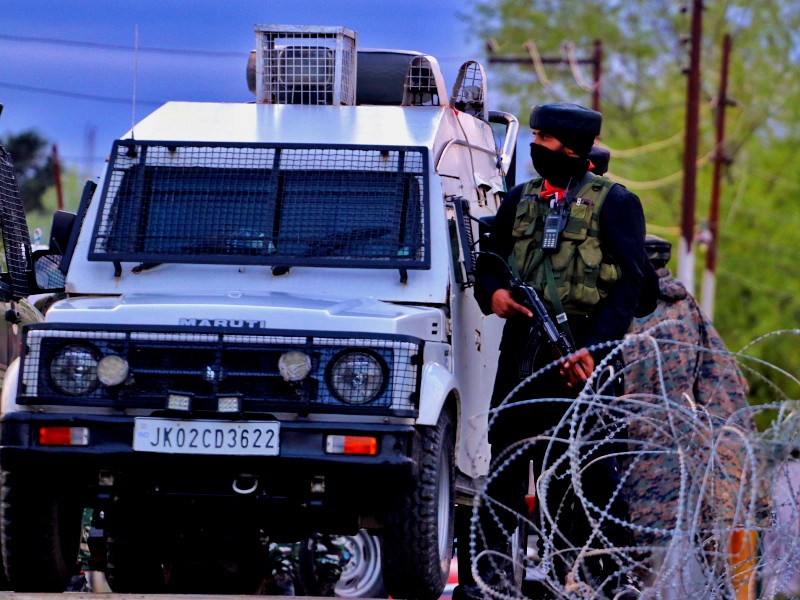
References
-
- (October 2019), ‘Imprisoned Resistance – 5th August and its Aftermath’, Page 5. Retrieved from http://www.pucl.org/sites/default/files/reports/Imprisoned%20Resistance-final%20for%20dissemination.pdf.
- ‘4,000 detained in Kashmir since autonomy stripped: govt sources’, France24 (18 August 2019). Retrieved from france24.com/en/20190818-4-000-detained-in-kashmir-since-autonomy-stripped-govt-sources.
- Express Web Desk (20 November 2019). ‘Parliament Winter Session highlights: Both Houses adjourned for the day’, Indian Express .Retrieved from indianexpress.com/article/india/parliament-winter-session-live-updates-lok-sabha-rajya-sabha-6127956/.
- Mathur, A (1 October 2019). ‘9-year-olds among 144 minors detained in Kashmir since Article 370 abrogation: Reports’. India Today. Retrieved from https://www.indiatoday.in/india/story/children-among-minors-detained-kashmir-article-370-abrogation-reports-1605322-2019-10-01.
- Donthi, P (16 August 2019). ‘One Solution, Gun Solution’. The Caravan. Retrieved from https://caravanmagazine.in/conflict/one-solution-gun-solution-gun-solution-kashmir-in-shock-and-anger.
- (2 November 2019). ‘MHA to continue to have final say on AFSPA in J&K’. KashmirLife. Retrieved from https://kashmirlife.net/mha-to-continue-to-have-final-say-on-afspa-in-jk-218598/
- Shukla, A (3 July 2018). ‘How many soldiers in Kashmir?’. Business Standard. Retrieved from https://www.business-standard.com/article/opinion/how-many-soldiers-in-kashmir-118070201160_1.html
- Sharma,V (18 August 2019). ‘Forces deploy 1 million to guard every inch of Kashmir valley’. Deccan Chronicle. Retrieved from https://www.deccanchronicle.com/nation/current-affairs/180819/forces-deploy-1-million-to-guard-every-inch-of-kashmir-valley.html
- Ibid.
- (7 December, 2017). ‘Ex gratia for slain cops’ kin hiked to Rs 70 lakh | KNO’. Kashmir News Observer. Retrieved from https://www.kashmirnewsobserver.com/fnews.aspx?id=11633
- Special Correspondent (1 February 2020). ‘Budget 2020 | Big jump in allocation to MHA with a separate fund for J&K’. The Hindu. Retrieved from https://www.thehindu.com/business/budget/budget-2020-big-jump-in-allocation-to-mha-with-a-separate-fund-for-jk/article30713691.ece
- Ahuja,R & Kumar,A (3 February 2020). ‘Health budget: blessing in disguise?. Economics Times. Retrieved from https://health.economictimes.indiatimes.com/news/industry/health-budget-blessing-in-disguise/73895586
- Singh, K (11 May 2020). ‘Shoved gun barrels in mouths, tied civilians to trees: A ransacked Budgam village’. The KashmirWalla. Retrieved from https://thekashmirwalla.com/2020/05/shoved-gun-barrels-in-mouths-tied-civilians-to-tree-a-ransacked-budgam-village/.
- Sexist verbal abuse
- Supra Note 479 at Page 34.
- Nair, R (21 July2016). ‘Pellet Guns in Kashmir: The Legal Use of Non-Lethal Weapons’. The Wire. Retrieved from https://the wire.in/rights/kashmir-lethal-pellet-guns.
- Supra Note 479 at Page 41.
- Office of the United Nations High Commissioner for Human Rights(8 July 2019). ‘Update of the Situation of Human Rights in Indian-Administered Kashmir and Pakistan-Administered Kashmir from May 2018 to April 2019’. United Nations Human Rights Office of the High Commissioner. Retrieved from https://www.ohchr.org/Documents/Countries/IN/KashmirUpdateReport_8July2019.pdf .
- Andrabi, K (17 July 2020). ‘Family accuses 20 year old son beaten by army: I thought he will die’. The KashmirWalla. Retrieved from https://thekashmirwalla.com/2019/03/family-accuses-20-yr-old-son-beaten-by-army-i-thought-he-will-die/ .
- Bhalla, A (26 June 2019). ‘No more pellet guns? Sound cannons could soon replace them’. India Today. Retrieved from https://www.indiatoday.in/india/story/pellet-guns-sound-canon-1556412-2019-06-26 .
- TNN (5 August 2019). ‘Arunachal Pradesh adds 5 anti-riot vehicles to the state police fleet.’. The Times of India. Retrieved from https://timesofindia.indiatimes.com/city/itanagar/arunachal-pradesh-adds-5-anti-riot-vehicles-to-state-police-fleet/articleshow/70531602.cms .
- PTI (13 July 2018). ‘Army quietly launches operation Calm Down in South Kashmir’. The Economic Times. Retrieved from https://economictimes.indiatimes.com/news/defence/army-quietly-launches-operation-calm-down-in-south-kashmir/articleshow/54311657.cms .
- Singh, J.B. (22 June 2017). ‘Operation All-Out: Army’s master plan to flush out all terrorists from Kashmir’. India Today. Retrieved from https://www.indiatoday.in/india/story/kashmir-terrorism-all-out-plan-lashkar-hizbul-jaish-militants-984216-2017-06-22 .
- Supra note 496 at page 4.
- (1 January 2018). ‘206 militants killed in Jammu and Kashmir in 2017’. The Week. Retrieved from https://www.theweek.in/news/india/206-militants-killed-jammu-kashmir.html
- Malik, I. (20 June 2020). ‘J&K Militancy Suffers Significant Losses as Security Forces Amp Operations Amidst Lockdown’. The Wire. Retrieved from https://thewire.in/security/jk-militants-commanders-gunfights-army
- Monitor News Bureau (19 June 2020). ‘Eight militants killed in south Kashmir gunfights’.The Kashmir Monitor. Retrieved from https://www.thekashmirmonitor.net/eight-militants-killed-in-south-kashmir-gunfight/ .
- Supra note 496 at page 17.
- Shah, F (9 June 2020). ‘All is gone: Four families of Shopian devastated after two gunfights.’.The KashmirWalla. Retrieved from https://thekashmirwalla.com/2020/06/all-is-gone-four-families-of-shopian-devastated-after-two-gunfights/.
- Supra note 496 at page 11.
- Jahangir, M (7 June 2020). ‘Security forces arrested 135 over ground workers in Kashmir this year, say officials.’.The Tribune. Retrieved from https://www.tribuneindia.com/news/j-k/security-forces-arrested-135-over-ground-workers-in-kashmir-this-year-say-officials-96224.
- Majumdar, N (6 March 2018). ‘Army says it killed OGWs in Shopian, Mufti says they weren’t. Who is an OGW?’. The Print. Retrieved from https://theprint.in/defence/mufti-refutes-army-claim-about-ogws-in-shopian-but-who-is-an-ogw/39609/.
- Singh, K. et al (10 June 2020). ‘We’re in disbelief: Ajay Pandita’s killing reminds of Kashmir’s vulnerable grassroot politics.’. The KashmirWalla. Retrieved from https://thekashmirwalla.com/2020/06/were-in-disbelief-ajay-panditas-killing-reminds-kashmirs-vulnerable-grassroots-politics/.
- Supra note 496 at 21.
- Routray, B. P (2017). ‘India: Fleeting Attachment to the Counterinsurgency Grand Strategy, Small Wars & Insurgencies’. 28:1, 57-80, DOI: 10.1080/09592318.2016.1266129
- ‘Doctrine For Sub Conventional Operations’, Integrated HQ of MoD (Army).pg 3.
- Gokhale, N.A. (2017). Securing India the Modi Way. Bloomsbury India Publishing Private Limited: New Delhi.
- Rajagopalan, R (2008). Fighting Like a Guerrilla: The Indian Army and Counterinsurgency.Routledge India: New Delhi.
- Aaron, S (16 September 2016). ‘Narendra Modi is implementing the Doval Doctrine in Kashmir’. Hindustan Times. Retrieved from https://www.hindustantimes.com/analysis/narendra-modi-is-implementing-the-doval-doctrine-in-kashmir/story-uPZfR9aNCPwFCD3VkTnWZN.html.
About the Author: Sarthak is an activist and labour organiser. His writings focus on media, climate crisis and national security.
All our work is available free of charge, if you wish to support our work by making a donation, so that we can continue to provide this vital service, please do so here.
This opinion article forms part of Kashmir Reading Room’s Yearly Report Aug 2019-Aug 2020. You can view the full report by clicking on the button below.
Disclaimer
The author(s) of every article and piece of content appearing within this website is/are solely responsible for the content thereof; all views, thoughts and opinions expressed in all content published on this site belong solely to the author of the article and shall not constitute or be deemed to constitute any representation by JKLPP, Kashmir Reading Room, the author’s employer, organisation, committee or other group or individual, in that the text and information presented therein are correct or sufficient to support the conclusions reached.
